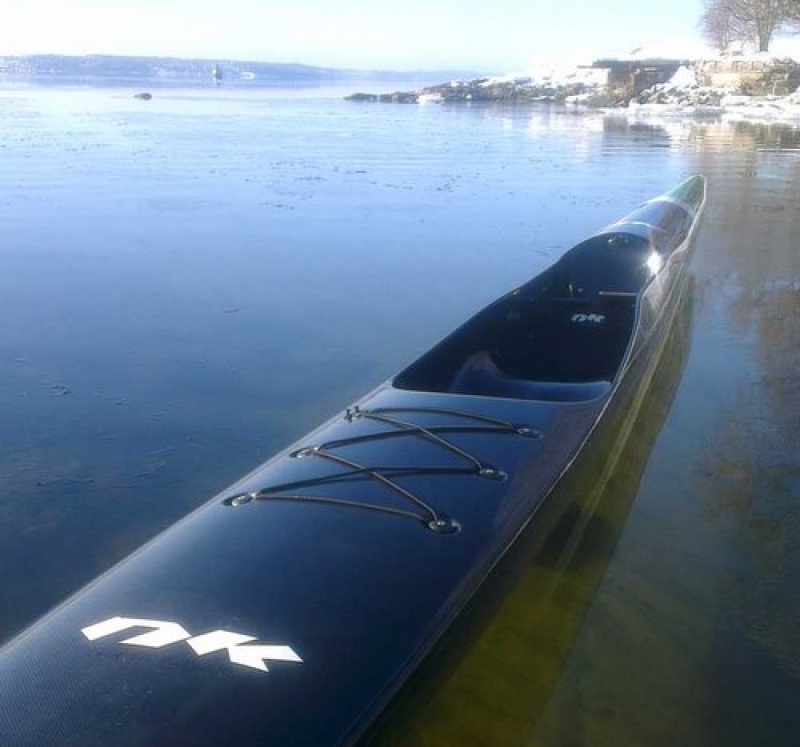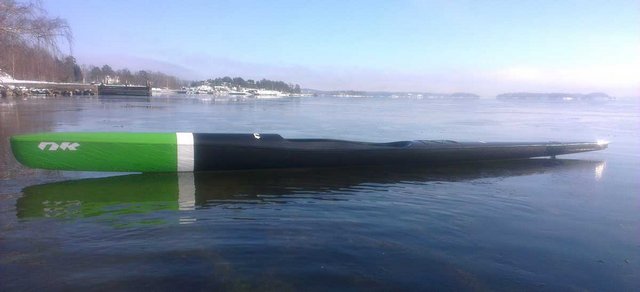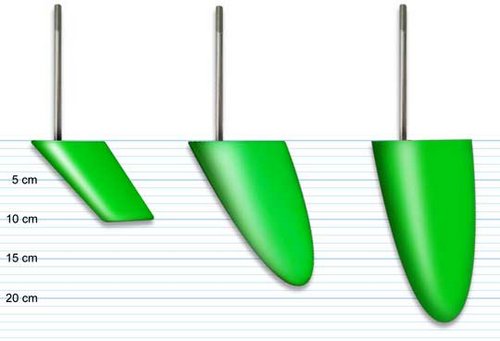Review: Nordic Kayaks NITRO and NITRO Plus
 Nordic Kayaks NITRO (Elite layup)
Nordic Kayaks NITRO (Elite layup)
Last year, Nordic Kayaks CEO Fredrik Lindstrom started sending me drawings and digital renderings of the new NITRO surfski. All my life I've been on high performance craft, rowing, sailing and paddling - and this one just looked right to me. In April I finally got the chance to paddle it and its brother, the NITRO Plus.
Oddities
For the first few years I paddled surfskis in Sweden, they were regarded as a real oddity. But some excellent results by half-decent paddlers in various popular long-distance races in Sweden slowly turned the spotlight on these funny looking craft.
Adventure racers were quick to catch on that crawling in and out of cockpits at portages and transitions was gone and that these boats were pretty fast and more stable than the regular adventure K1s they were using.
I suspect that NK's first surfskis were designed with these adventure racers in mind. I've known Frederik for as long as I've been paddling in Sweden and it's been my pleasure to be on the receiving end of requests for feedback on his new prototypes.
The build quality has always been extraordinary (Frederik pushes the envelope with what's technically possible, and cooperation with Sweden's - and dare I say it, the world's - best carbon-fibre experts resulted in some insanely light (8 kg or thereabouts) craft that looked like nothing else.
Not my thing
But the skis that came out weren't really my thing. I like catching runs so small you can hardly see them - but I also like riding storm swells on open water. The first NK skis were great long-distance mile-eating machines, but I just didn't feel at home in them. (Many, many adventure racers did, however.)
The Search for the Perfect Ski
I have to admit that my ability to tell what works in a boat hasn't always worked out. I could hardly sit in my first kayak; and even when I mastered it, the wake of a duck could set me swimming. I won't mention what boat it was, but it started with "Sea" and ended with "ish"!
Nevertheless, over the years, I've found myself judging boats by a set of guidelines – if they all check out, then I pretty much always click with the boat:
- Well built, reliable quality, nice finish
- Good working rudder setup, no play in the rudder pedals, stiff footboard, well balanced surf rudder, safe system that doesn't wear out quick.
- Easy hull shape that has enough volume to get lift from bumps, turns easily while keeping its line.
- A bucket that's comfortable without padding, and easy to re-enter
- A brand that has international ambitions and wants to be at races and supports them
And...
After years in my V10 performance, I paddled half a summer in a Red7; a year in a V12 Ultra, 2 years back in a V10 Ultra, 1 year in a Hawx.
Enter the V14
Come this last winter (the winter-that-never-arrived) and I felt that I should try the next generation of super fast skis.
Sweden being blessed with proper winters I usually spend some months off the water but, in spite of having the most hectic work travel schedule ever, I managed to keep myself fit - training in weird gyms in hotels and airports. So I wasn't as out of shape as I might have been when I got back on the water.
I had bought a used V14 Ultra and by March felt it was time to get on the water and try it out.
The speed was incredible. Where I usually have had to work hard to average 12kph on my hour-long sessions on the water, I noticed immediately this was very easy on the V14. On flat days I was regularly doing 12,3kph average over the session... in cold slow water with loads of gear on!
The ski seemed to have no maximum speed: paddle harder and it goes faster. It never sits down into the water and says, "hey, this is as fast as I go".
Comes with a price
But, for me, this outstanding performance comes with a price in terms of stability and in the back of my mind I was thinking, yes, the speed is amazing, but on a big day in unknown waters? What then?
In the meantime I was enjoying the flat water and my newly found speed like never before.
Nordic Kayaks NITRO
Come April and Fredrik and I got in touch. I had been aware that NK had expanded their range: the three existing models (low volume fast, entry level and intermediate) had now been joined by the two NITRO top end racing skis. I also knew that Freddie had been travelling back forth to Asia all winter and that he's working with a factory there that is one of the best fabricators around.

The NK Nitro in elite layup
On paper
The new NITROs look pretty good on paper. Clean, easy lines; some rocker; some volume. They don't stand out as very extreme shapes – but to me that's good. They look... predictable.
To me, surfski paddling is all about prediction: predicting where the next run is going to start – and predicting how the ski is going to react when you go for it. Of course your skill and fitness levels are important, but so is the ski that you're sitting on.
And in the flesh...
I picked up a NITRO Plus in Kevlar layup and NITRO in full carbon. The Plus is a half cm wider than the NITRO and has a bit more volume, slightly higher gunwales and in this case is white. The NITRO has a transparent clear gelcoat and is therefore carbon-fibre black. The cockpit has black gelcoat.
Finish
About as good as you can get it. Clearly they're hand made so you can see minor imperfections - on the seam for instance. But honestly, it's as good as a human can achieve, and the boats look very slick. The tricky parts, like the rudder shaft, the spots where the rudder lines emerge, etc are all done with great care and finished off beautifully. Both boats just ooze quality.
When picking up the Plus in Kevlar, it feels very familiar to my Epic's Ultra layup in weight. I didn't check it, but it's certainly light enough!
The NITRO I paddled is full carbon, and that really does feel VERY light.
The white kevlar finish is my favorite: it's not as light and feels less hard as the carbon, but the white cockpit and hull for me feel really fresh. Small scratches and paddle strikes are less obvious on the white finish, while on the transparent clearcoat every little scratch becomes a white scratch. The black cockpit also shows dirt and scratches much more and is also hotter in summer.
Ideally would be a white cockpit on the carbon ski, but that's just my personal taste.


The sharp end
Bits 'n pieces
Footplate Assembly
The footplate is pretty straightforward; Proven technology is used here and the lines self-adjust as you change leg-length.
The plate and pedals are made out of carbon and have foam padding as standard. There are also small rubber bumpers under the plate to protect the hull from damage when pushing hard.

Footplate assembly
Rudder lines are dyneema and hardly stretch. When I push on both pedals simultaneously they move maybe 0,5 cm forward which is acceptable.
Bailer
The bailer is a plastic version of the much used Anderson bailer as used on sailing dinghies that can be opened and closed. It has a little flap in it to prevent water from backing in if you are laying still, paddling too slow or reversing.
However this means you need to open the bailer at least 75% to be far enough that the flap can actually open. I rather removed the flap, which is easily done, so I can have the bailer just as far open as necessary.

Wide open is too wide

1cm is right for flat water
Paddling at 11-12 kph and weighing 96kg with paddle means I set about a 1cm opening for it to just not gurgle. In big conditions 2cm is about right. When wide open it sucks so hard you risk losing body parts if not wearing neoprene shorts.
Rudder Assembly
The housing for the rudder is different to other boats I've seen. The back of the housing is open and the T-bar is simply covered with a lid secured by a stainless steel bolt. (The bolt screws into a nut laminated into the hull of the ski – a much better solution than the simple screw often seen on other skis.)
I think it's a little over-engineered though! A plastic knob, removable by hand, would do the job just as well and wouldn't require the allen key (that is included in a stowage behind the footplate).

The T-bar housing
I do like being able to see the T-bar though, to check it before heading out into big conditions...

Nordic Kayaks offers a range of rudders
Behind the rudder is a small deck fitting that can be used for an emergency steering bungy in case of a snapped rudderline. I guess it could also be used by adventure racers who always seem to want to tow each other!
Leash Anchor
There's a leash anchor fitting in the cockpit, in common with many other skis. I tried it for the first time and it does make sense; I much prefer it to hooking my leash on the footstrap. How strong the leash is, I don't know.
Deck Bungees
Behind the cockpit, a set of six deck fittings secures a web of bungee cables. Fenn skis, perhaps the most popular brand, don't have this feature and I often see paddlers scratching their heads, wondering how to carry a small bag or PFD.

The NITRO Bucket
Paddling the skis
To be honest, choosing one of these two after a short test paddle would be very difficult. But, having spent time in them I'm confident that, whichever I chose, I'd be happy with it.
Comfort
Both skis have perfectly shaped buckets – for my backside; I found the NITRO's bucket slightly deeper and more hollowed out, giving more support to my lower back. (It also makes my shorts chafe a little more against my lower back – but I think the seam on the shorts is more to blame than the seat.)
NITRO Plus

The bucket in the Plus is a bit roomier and the hump is lowish. The benefit of this is that your legs are straighter and lower – helpful for stability and leg drive. On the other hand, any water that gets in easily sloshes back from the footwell into the bucket, freezing your appendages off in winter!
Footplate Angle
The angle on this one is just right. I found the Fenn footplate, for example, needed about two years of yoga before I could get my heel on it!
It's not adjustable (unlike the Nelo for example), but then surfski paddlers don't generally expect that.
Mine did make a funny squeaking sound when I pushed hard, but I cured it by filling the empty space behind the footplate with closed cell foam blocks. This gives the footplate the ultimate solid feel; being an ex-rower I like to use my legs as much as possible. And the blocks reduce the volume of water if you do flood the cockpit.
Friendly - with Attitude
I found immediately that the Plus is a friendly ski, but with attitude.
Definitely a thoroughbred racer; my cruising speeds were right there where I wanted them to be.
Having spent the last couple of years in Epic surfskis, I can most easily compare the NITROs to them. In a nutshell I'd say that I found the Plus more stable than the V14, and more spicy than the V10.
After having paddled it in flatwater races, big downwinds, ferry wake riding and races on tiny swell conditions, I feel very confident in my judgment of this ski.
It is SO un-dramatic to paddle.
Very predictable in the downwind, fast enough on the flat, and so stable that you dare take it out on any day. For me this really grew into to the one do-it-all ski that I could feel really happy with in any conditions from the wild west coast to flat downtown Stockholm. I have completely crushed all my best times this spring using the Plus, and this to me really proves that it's a fast ski. I think some of my regular training and racing buddies can confirm this.
After watching the downwind videos all winter by Rob Mousley in Cape Town and Boyan Zlatarev in Tarifa, it was pure joy when it was finally my turn again.
To sit in a ski that is predictable and fast that allows you to do what you want to do is just fantastic.
So I can't really say much more about the Plus. Stable, fast enough, easy, predictable, nothing crazy, just plain good, as a real surfski should be.
The NITRO (not Plus!)

Then came the day Fredrik needed his Plus back for some demos and he swapped it with the NITRO.
Until then I was sure... the Plus is my ski... it's all I want a ski to be...
But this changed abruptly after a very short paddle in the NITRO.
A buddy was paddling my V14 and I was in the NITRO. We were just going for a short flat-water cruise as we were both recovering from a tough weekend of racing and it was 07:00 in the morning.
Personal Best - shattered
We left the dock and after 200m I noticed my gps settling at 12,5 km/h. WHAT? I'm just cruising. My mate was wondering if I was in a hurry... ok this ski is even faster.
When getting in you might feel less comfortable pressing the buttons on your gps; this ski is definitely a little more tippy. There is a solid secondary stability, but initial stability is perceptibly less than the Plus.
I would still judge it a fraction more stable than the V14 but not much.
I have now done a couple of my "hour of power" sessions in it as I call my 60min grind, and records are being pulverized with each session. Even when I really tell myself to take it easy this time, I end up cranking hard; it's an addictively fast ski.
Downwind
A few weekends ago we had a relatively big downwind and I installed the bigger surf rudder for the trip.
Our course was slightly angled over a 1,5m wind swell with 20kt wind at a 70degree angle. Conditions were fantastic and I had a total blast.
I would say the NITRO is a bit more tricky to handle than the Plus but still predictable and easy to maneuver all over the wave. When riding the swells up high, if you keep the nose out of the water you can keep it pretty dry. But when going for the wild and crazy dash down the wave... you will get wet.
Volume in the nose is enough to make it pop up when at speed and maneuvered in the right direction. Launching over waves at speed is easy.
Flat-water Race
I also managed to do a flat-water race downtown.
We did a 9km course where I spent 75% (arguable obviously ;-)) of the time paddling alone or in the front of our 2-man bunch. I increased my average speed from 12,65kph to 13,35kph - and this when conditions were not ideal.
Better Technique
Sure I think I'm paddling technically slightly better than before. But the ski is letting me do that too. The seat in the NITRO feels slightly higher than the Plus, and therewith slightly higher than most skis. This really makes the position better from an efficiency point of view, but obviously it comes at a cost for some stability.
The area where your calves are is tight in the NITRO. Much more open with the V14, and somewhere between with the Plus. However, I'm not tiny and you get used to the snug fit. It also gives some support and contact when paddling in big water with the ski moving in all sorts of directions.
And finally…
So after having written all this, I think that if I had to choose only one ski, I'd take the Plus - but I would definitely be asking Fredrik if he could lend me that NITRO every now and then. Why the Plus? Simply because paddling downwind is my goal, and everything else is just practice for that.
And when a good downwind comes, I just want the ski to do what I want, and I do not want to have a voice in the back of my mind saying, "You idiot, you should have a more stable ski for this day..."
For many paddlers both skis might be too tippy, and not a great choice and the NK Squall, the V10 Sport or the NK Storm might be the way to go.
Of course much has to do with what kind of paddler you are and where you want to paddle. If downtown city paddling is your thing and all races are flat or just have some boat swell, I guess you could be more aggressive with your choice of ski...
However, if you own a car with roof racks and your smartphone has more weather apps than social media apps than you should perhaps be thinking towards a more conservative option.

